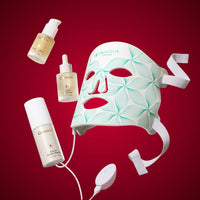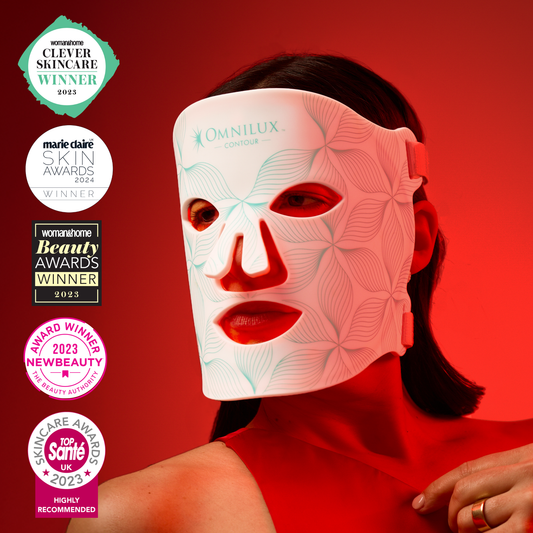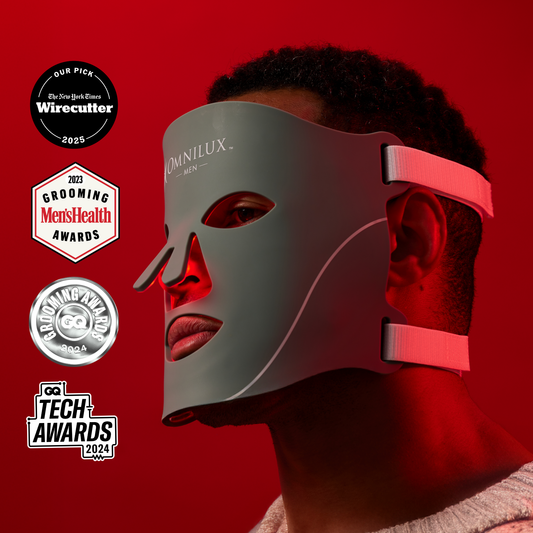
How Does LED Light Therapy Treat Acne Naturally?
Affecting up to 50 million Americans every single year, it’s safe to say acne is one of today’s most pressing skin concerns. But, acne has far-reaching effects beyond those little red bumps – it can seriously impact self-esteem and cause frustration when you catch a glimpse in the mirror.
This Acne Awareness Month, we’re here to say you’re not alone, and acne isn’t forever. With support from trusted skin experts and today’s range of clinically proven acne treatments, clear skin is well within your reach.
Whether you’re looking to avoid that occasional pimple or soothe inflammatory breakouts, LED light therapy is an effective tool for your acne arsenal. Below, we’ll dive into exactly how blue and red light therapy can zap pesky zits while preventing future breakouts with insights from three esteemed dermatologists and members of our Scientific Advisory Board: Dr. Klaus Fritz, MD; Dr. Jared Jagdeo, MD, MS; Dr. Glynis Ablon, MD, FAAD.
Breaking Down the Benefits of Blue Light Therapy for Acne-Prone Skin
Blue light offers compelling benefits for acne-prone skin. Dr. Jagdeo notes, “Blue light therapy is beneficial for acne-prone skin because it helps decrease bacteria on the surface of the skin that causes acne, clogged pores, and congestion.”
Let’s dive into the benefits of blue light for acne in greater detail:
-
Reduces inflammation: Inflammation is the primary culprit behind red, swollen acne lesions. “Blue light therapy helps reduce the inflammation associated with acne,” notes Dr. Fritz. “This can lead to less redness and swelling, improving the overall appearance of the skin and making breakouts less severe.”
-
Tackles current breakouts and prevents future ones: While treating existing acne breakouts is important, we’d also like to prevent those pesky pimples from appearing in the first place. Dr. Fritz states, “By reducing the population of P. acnes bacteria on the skin, blue light therapy can help prevent future acne breakouts. This makes it a useful preventative treatment for individuals who frequently suffer from acne.”
-
Minimizes sebum production: Your skin produces sebum, an oily, waxy substance, for hydration and protection against external irritants. But, excess sebum can clog your pores, leading to breakouts. “Some studies suggest that blue light therapy can help decrease the production of sebum,” Dr. Fritz notes. “By reducing sebum production, blue light therapy can make the skin less prone to developing pimples.”
-
Non-invasive and painless: When acne treatments are uncomfortable or painful, they can be difficult to stick to. Dr. Fritz notes that “blue light therapy is a non-invasive treatment, meaning it does not involve needles, incisions, or other invasive procedures. It is generally painless, with most people experiencing only mild warmth or tingling during the treatment.”
-
Low risk of side effects: According to Dr. Fritz: “Blue light therapy typically has few side effects. The most common side effect is temporary redness or dryness of the treated area, which usually resolves quickly. This makes it a suitable option for people who cannot tolerate the side effects of traditional acne treatments like topical retinoids or oral antibiotics.”
- Convenient: Convenience in acne treatments is key, as it can help you stick to a steady regimen. “Blue light therapy can be administered in a dermatologist's office or at home using FDA-approved devices”, Dr. Fritz notes. “Home devices allow for convenient and consistent treatment, making it easier for people to incorporate it into their skincare routine.”
The Omnilux Clear mask is an FDA-cleared device that delivers 415nm blue light to target and kill P.acnes bacteria on the skin’s surface – all from the comfort of your home. The Omnilux Mini Blemish Eraser features the same blue light wavelength (plus the acne-fighting powers of salicylic acid and green tea in our concentrated Hydrocolloid Patches) in a low-cost, pocket-sized package for ultra-targeted treatments.
But, that’s not all: Omnilux Clear and the Blemish Eraser also feature 633nm red light to stimulate the skin’s healing process, calm inflammation, reduce redness, ramp up collagen production, and curb excess sebum.
The Supporting Act: How 633nm Red Light Complements Blue Light Therapy for Acne
Blue light therapy may be the star of the show for treating acne, but red light therapy offers skin-soothing benefits of its own. Dr. Jagdeo notes: “In combination with blue light therapy, red light therapy has anti-inflammatory properties that decrease the redness and inflammation associated with acne.”
So, while blue light therapy curbs bacteria, “red light therapy focuses on reducing inflammation and promoting skin healing”, says Dr. Fritz. “Red light therapy penetrates deeper into the skin than blue light, reaching the dermis where inflammation occurs. It helps to reduce inflammation associated with acne, leading to less redness and swelling. This can make active breakouts less noticeable and more manageable.”
Red light therapy can also help your skin bounce back faster after a breakout. “Red light stimulates the skin's natural healing process [and] can help repair damaged tissue and reduce the appearance of acne scars over time,” Dr. Fritz notes. “It also improves blood flow, resulting in more oxygen and nutrients to the skin cells, and reduces sebum production.”
As part of your regular skincare regimen, red light therapy can place your acne woes firmly in the rearview. “By promoting collagen production and improving skin elasticity, red light therapy can help reduce the appearance of acne scars. Over time, regular treatments can lead to smoother skin texture and more even skin tone.”
What’s Really Happening During LED Light Therapy?
Do you ever wonder what’s actually happening to your skin during your LED light therapy sessions? We asked our Scientific Advisory Board for a complete run-down on the details.
415nm Blue Light Treatment
According to Dr. Fritz, “Blue light at 415nm is absorbed by porphyrins, which are naturally occurring molecules produced by Propionibacterium acnes (P. acnes), the bacteria involved in acne. Porphyrins are particularly sensitive to blue light.”
“When porphyrins absorb blue light, they become excited and undergo a photochemical reaction that produces reactive oxygen species (ROS). These ROS are toxic to the bacteria, effectively killing them. The decrease in P. acnes bacteria reduces the overall bacterial load on the skin, leading to fewer and less severe acne breakouts.”

633nm Red Light Treatment
Red light therapy, on the other hand, penetrates more deeply into the skin, reaching the dermis layer. Dr. Fritz notes, “This deeper penetration allows red light to affect skin cells and tissues that blue light cannot reach. Red light is absorbed by chromophores in the mitochondria of skin cells. This absorption increases the activity of the mitochondria, boosting the production of adenosine triphosphate (ATP), the energy currency of the cells.”
“Enhanced ATP production leads to increased cellular activity and regeneration. It also improves blood circulation in the treated areas. Better circulation means more oxygen and nutrients are delivered to the skin cells, aiding in the healing process and overall skin health.”

Building Your Acne Treatment Plan: Lifestyle Adjustments to Prevent Breakouts
In our chat with our Scientific Advisors, we asked if they recommended avoiding specific skincare ingredients, and treatments for acne-prone skin. Their tips can be incorporated into a well-rounded approach to acne, considering every aspect of your lifestyle and how it might impact your skin.
According to Dr. Jagdeo, “It’s difficult to provide a generalized answer since everyone’s skin and acne is unique! Therefore, I always recommend seeing a board-certified dermatologist or other skin professional to develop a plan that’s right for you.”
“Overall, if you have oily and acne-prone skin, you may find success opting for lighter weight products like a gel cream moisturizer instead of thicker creams and oils that could worsen clogged pores.”
Skincare Ingredients to Avoid for Acne-Prone Skin
Generally, people with acne-prone skin should steer clear of these ingredients in skincare:
-
Comedogenic ingredients: If an ingredient is comedogenic (such as heavy oils like coconut oil or butters like cocoa or shea butter), it has the potential to clog your pores.
-
Harsh scrubs: According to Dr. Fritz, “physical exfoliants with large, rough particles (e.g. walnut shells) can irritate the skin and worsen acne.” Additionally, over-exfoliation can cause irritation and inflammation, exacerbating existing breakouts. Your dermatologist can recommend an exfoliant (and exfoliation schedule) that best suits your skin.
-
Fragrances and dyes “can be irritating and cause inflammation, leading to breakouts” notes Dr. Fritz. Closely examine the label before purchasing a skincare product, looking for fragrance aliases like perfume, parfum, scent, and cologne.
- Alcohol-based products: Dr. Fritz states: “Ingredients like SD alcohol and denatured alcohol can strip the skin of its natural oils, causing it to produce more oil and potentially leading to more breakouts. Sodium lauryl sulfate (SLS) and sodium laureth sulfate (SLES) can be harsh on the skin, causing irritation and dryness.”
Skin Treatments to Avoid for Acne-Prone Skin
Certain treatments can cause more harm than good for acne-prone skin. Dr. Fritz suggests keeping clear from aggressive facials and extractions, which can trigger more inflammation than they’re worth. He also recommends avoiding oil-based makeup and heavy creams and ointments, which can block pores and lead to acne.
Is LED Light Therapy Right for My Acne?
All Omnilux LED devices are medical-grade, FDA-cleared, CE-certified, and TGA-approved. They’re also backed by extensive clinical research supporting their safety and efficacy. So, while Omnilux LED light therapy is proven to be safe, it may not work for more severe forms of acne.
“I recommend blue and red LED light therapy for people with mild to moderate inflammatory acne (think red, pus-filled pimples). Folks with severe acne may need a more intensive treatment to clear the skin,” Dr. Jagdeo notes. “For patients with mild to moderate acne, you can often get great results with gentler treatments like LED light therapy and topical products while avoiding side effects that come with oral treatments.”
Dr. Fritz adds, “Light therapy can be a first step of self-therapy with a home device. If this is not sufficient, in most patients, topical creams with ingredients like benzoyl peroxide are very helpful. Systemic medication with pills that need to be [taken] orally [are] only necessary in very severe cases.”
“At all levels of severity, light therapy helps to reduce the inflammation and can reduce the dose or the duration of medication and helps to maintain and prevent new acne flares.”
Busting Common Acne Myths
Fact or fiction? With the plethora of acne tips floating around social media today, it can be difficult to tell the difference. Our advisors offer clarity in the sea of online information.
“Do not believe the myths, false ideologies, and other rubbish you find a million times on social media,” said Dr. Fritz. “Always be aware that a case report on improvement [with] a certain treatment does not automatically mean that you will improve as well. Medication is safe only if it has been tested for affectivity on hundreds of patients and has been proven not to cause side effects.”
Dr. Jagdeo adds: “I think when folks don’t consult an expert, we often see them trying too many harsh active ingredients at once and ultimately end up irritating their skin and causing more breakouts. I know it’s tempting to try as many products as possible to clear your acne, but a simple skincare routine is often best!”
With those key insights in mind, let’s debunk a few common acne myths in honor of Acne Awareness Month:
Myth #1: Washing your face repeatedly throughout the day helps with acne.
The truth: Washing your face more than twice daily can strip your skin of its natural oils, which play an essential role in the skin’s protective barrier. If this barrier is compromised, it can actually exacerbate acne by causing further irritation and inflammation.
Drying out your skin by over-washing can also make your skin produce more oil in an attempt to shield itself from environmental stressors. These oils can combine with bacteria and dead skin cells to clog your pores.
Myth #2: Acne is always a sign of poor hygiene.
The truth: Acne (especially inflammatory acne) can be triggered by a vast range of factors, including genetics, hormones, age, and environmental factors. It’s far more complicated than hygiene, and many people with strict cleansing routines still struggle with breakouts.
Myth #3: Only teenagers get acne.
The truth: If only this one were true! Alas, adult acne is extremely common. Hormonal fluctuations and age-related skin changes can trigger acne in your 20s, 30s, 40s, and 50s – even if you were acne-free throughout adolescence.
Myth #4: The more products, the better.
The truth: You heard Dr. Jagdeo: Oftentimes, simple is best. Using too many skincare products (especially products with active ingredients for acne) can dry out and irritate your skin. Additionally, certain ingredients can deactivate each other (like retinol and benzoyl peroxide), sabotaging the touted benefits of your acne treatments.
The Future is Bright for Acne Treatment
Acne has a long, storied (and dare we say complicated?) history. In ancient Rome, a court physician famously endorsed wiping a pimple with a cloth while watching a falling star as a trusted acne remedy. While we’ve come a long way since the 4th century AD, it wasn’t so long ago that treatment options – especially home remedies – were extremely limited.
As medical research has continually evolved and advanced, we’ve learned more about what causes acne and how to effectively treat it. Our advisors agreed that while breakouts remain a prevalent skin concern, the future of acne treatment is changing for the better.
“There are many new developments in acne treatment,” says Dr. Jagdeo. “One thing I’ve noticed is the availability of clinic-level treatments at home are becoming increasingly popular and accessible.” At Omnilux, we’re proud to contribute to this wave of accessibility with clinical-grade home LED light therapy devices for acne and skin rejuvenation.
Dr. Glynis Ablon adds, "With the overwhelming information on social media, people of all ages are searching for treatment options for acne that can be done at home, and on a budget. The pathophysiology is becoming clearer, and decreasing inflammation and decreasing curtobacterium on the skin is what low-level laser devices do.”
“The medical profession now acknowledges that you don't have to have pain to get results! Omnilux offers home units, as well as in-office procedures, that have dramatically improved this common skin condition that affects all age groups and skin types."
Parting Words For Clearer Skin
We’ll sign off with our experts’ top tips for people struggling with acne: “Get [a] medical consultation from [a] dermatologist early to classify your type of acne and [learn] about your therapeutic options,” says Dr. Fritz.
Dr. Jagdeo agrees: “My #1 tip is to see a board-certified dermatologist or other skin expert to develop a plan that’s specific to your skin’s needs.”
We’d love to be a part of your journey to clearer skin. Start with the Clear Assessment to see if Omnilux Clear is right for you!









